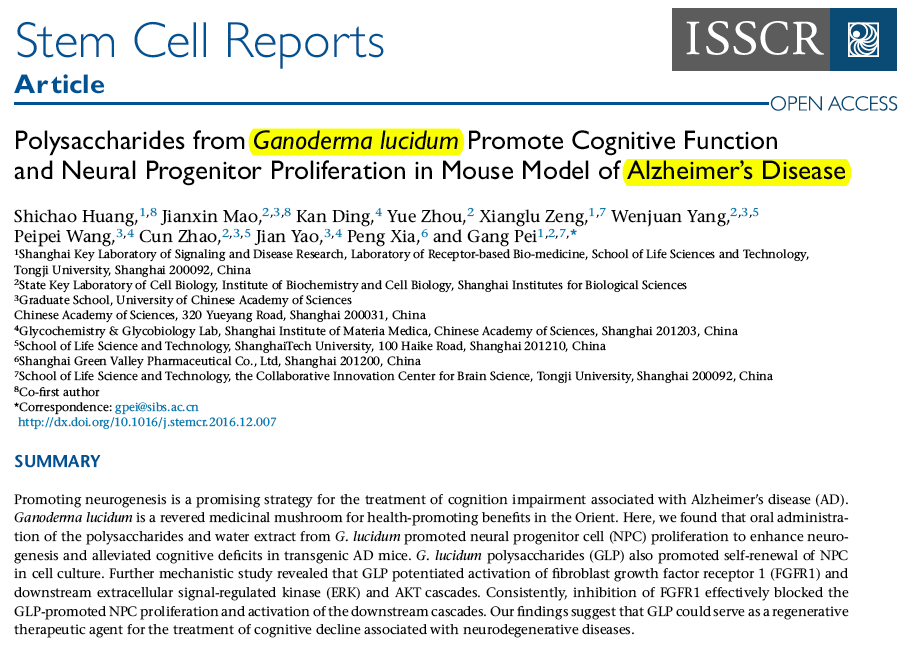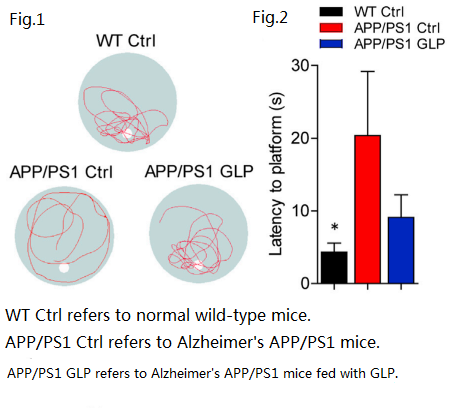1월 10, 2017 /통지대학교, 상하이 메디카 물질 연구소, 중국과학원, 등. / 줄기세포 보고서
문자/우 팅야오

“당신이 누구인지, 내가 누구인지 잊어라”는 것이 알츠하이머병의 가장 대표적인 증상이라고 할 수 있습니다. 잊어버리는 이유, 또는 최근 사건을 기억하지 못하는 경우, 인지기능을 담당하는 신경세포가 세월이 지나면서 조금씩 죽어간다는 것입니다., 이는 성인의 인지 수준을 지속적으로 퇴화시킨다..
점점 더 널리 퍼지고 있는 알츠하이머병에 직면해 있습니다, 과학자들은 가능한 치료법을 연구하기 위해 열심히 노력하고 있습니다. 어떤 사람들은 신경세포 사멸을 일으키는 원인에 초점을 맞춥니다., 베타-아밀로이드 단백질 생산을 줄이려고 노력 중입니다.; 다른 사람들은 신경 세포 재생을 촉진하는데 전념하고 있습니다, 신경세포 손상의 공백을 메우고자, 그것은 아마도 '부족하면 보충한다'는 개념일 것이다.
성숙한 포유류의 뇌에서는, 실제로 새로운 신경 세포를 계속 생성하는 두 영역이 있습니다, 그 중 하나는 해마이랑에 있습니다.. 이러한 자가 증식 신경 세포를 “신경 전구 세포”라고 합니다.. 그들로부터 새로 태어난 세포는 원래의 신경 회로에 추가되어 새로운 기술을 배우고 새로운 기억을 형성하도록 돕습니다..
하지만, 알츠하이머병이 신경 전구 세포의 증식을 방해할 수 있다는 것이 인간이나 생쥐에서 관찰될 수 있습니다.. 요즘에는, 신경 전구 세포의 증식을 촉진하면 알츠하이머병으로 인한 인지 저하를 줄일 수 있고 알츠하이머병 치료를 위한 실행 가능한 전략이 될 수 있다는 증거가 점점 더 많아지고 있습니다..
1월 2017, 공지대학교 'Stem Cell Reports'에 공동 게재된 연구, 상하이 생물학 연구소, 중국과학원, 등., 다당류 또는 물 추출물이 입증되었습니다. 영지버섯(영지버섯, 링지) 알츠하이머병으로 인한 인지 장애를 완화할 수 있습니다., 아밀로이드-β의 침착을 감소시킵니다. (Aβ) 뇌 속에, 해마이랑의 신경전구세포의 재생을 촉진합니다.. 후자의 작용 메커니즘은 신경전구세포의 FGFR1이라는 수용체의 활성화와 관련이 있을 가능성이 높습니다. 영지버섯.
먹는 알츠하이머 생쥐영지버섯 기억력이 좋아진다.
이번 연구에서 사용한 동물실험은 5 6개월 된 APP/PS1 형질전환 쥐에, 유전자 전달 기술을 사용하여 돌연변이 인간 유전자 APP 및 PS1을 전달합니다. (유전성 조기발병 알츠하이머병을 유발할 수 있는) 유전자의 효과적인 발현을 위해 새로 태어난 쥐에. 이는 쥐의 뇌에서 아밀로이드-β를 생성하기 시작하게 합니다. (Aβ) 어릴 때부터 (~ 후에 2 개월), 그리고 그들이 성장하면 5-6 개월, 점차적으로 공간 인식과 기억에 어려움을 겪게 됩니다..
다시 말해서, 실험에 사용된 쥐는 이미 알츠하이머병 초기 증상을 보인 상태였다.. 연구자들은 그러한 알츠하이머병 쥐에게 GLP를 먹였습니다. (에서 분리된 순수한 다당류영지버섯 분자량을 갖는 포자 분말 15 kD) 매일 복용량으로 30 mg/kg (즉, 30 하루 체중 1kg당 mg) ~을 위한 90 연속 일.
그 다음에, 연구원들은 또 다른 시간을 보냈다 12 모리스 물 미로에서 생쥐의 인지 능력을 테스트하는 날 (MWM) 아무런 치료도 받지 않은 알츠하이머병 쥐와 정상 쥐의 쥐와 비교했다..
생쥐는 선천적으로 물을 싫어하는 경향이 있습니다.. 물에 넣었을 때, 그들은 쉴 수 있는 건조한 장소를 찾으려고 노력할 것입니다. “모리스 수중 미로 테스트”는 그 특성을 이용하여 대형 원형 수영장의 고정된 위치에 휴식 플랫폼을 설치합니다.. 플랫폼이 물속에 숨겨져 있기 때문에, 쥐는 학습과 기억을 통해서만 그것을 찾아야 합니다.. 결과적으로, 연구자들은 쥐가 플랫폼을 발견했을 때 쥐가 더 멍청해졌는지 아니면 더 똑똑해졌는지 판단할 수 있었습니다., 그들이 수영한 거리와 그들이 걸어온 길.
각 그룹의 생쥐의 수영 속도에는 큰 차이가 없는 것으로 나타났습니다.. 하지만 일반 쥐에 비해, 아무 치료도 받지 않은 알츠하이머 쥐들은 마치 운이 좋은 것처럼 무질서한 길을 따라 플랫폼을 찾기 위해 더 많은 시간을 보내고 더 먼 거리를 헤엄쳐야 했다, 공간 기억이 크게 손상되었음을 나타냅니다..
대조적으로, 알츠하이머 쥐에게 먹이를 주다 영지버섯 다당류 또는 영지버섯 물 추출물이 플랫폼을 더 빨리 발견했습니다., 그리고 플랫폼을 찾기 전에, 그들은 주로 그 지역을 돌아다녔다 (사분면) 플랫폼이 있던 곳, 마치 플랫폼의 대략적인 위치를 알고 있는 것처럼, 뇌 손상이 덜 심각하다는 것을 나타냅니다.. 【수치 1, 그림 2】
게다가, 연구자들은 또 다른 실험에서 다량의 아밀로이드-β를 생산하는 초파리의 경우 (Aβ) 그들의 두뇌 속에 (또한 유전자 전달 방법을 통해 실험 모델을 구축합니다.), 영지버섯 물 추출물은 초파리의 공간 인식 및 기억 능력을 향상시킬 뿐만 아니라 초파리의 수명을 연장할 수 있습니다..
연구진은 또한영지버섯 물 추출물 (300mg/kg/일) 앞서 언급한 동물실험에서 앞서 언급한 것과 마찬가지로 알츠하이머병으로 인한 공간인지 장애도 완화할 수 있다는 사실이 밝혀졌습니다.영지버섯 다당류 (GLP).

쥐의 공간 기억 능력을 평가하려면 "Morris Water Maze Test"를 사용하십시오.
[수치 1] 각 그룹의 생쥐의 수영 경로. 파란색은 수영장이에요, 흰색은 플랫폼 위치입니다., 빨간색은 수영로입니다.
[수치 2] Morris 수중 미로 테스트 7일째에 각 마우스 그룹이 휴식 플랫폼을 찾는 데 필요한 평균 시간
(소스/줄기세포 보고서. 2017 1월 10;8(1):84-94.)
링지 해마회에서 신경전구세포의 증식을 촉진합니다..
12일간의 수중 미로 테스트 이후, 연구자들은 쥐의 뇌를 분석한 결과 다음과 같은 사실을 발견했습니다.영지버섯 다당류 및영지버섯 물 추출물은 해마이랑의 신경 세포 재생을 촉진하고 아밀로이드 베타 침착을 감소시킵니다..
또한 해마이랑에서 새로 탄생하는 신경세포는 주로 신경전구세포인 것으로 확인됐다. 그리고영지버섯 알츠하이머병 쥐에 효과적이다. 정상적인 젊은 성체 쥐에게영지버섯 다당류(GLP) 매일 복용량으로 30 mg/kg에 대한 14 며칠은 또한 해마회에서 신경 전구 세포의 증식을 촉진할 수 있습니다..
또한, in vitro 실험을 통해 정상 성체 생쥐나 알츠하이머 생쥐의 해마회에서 분리한 신경전구세포나 인간줄기세포에서 추출한 신경전구세포에 대해서도 확인된 바 있다., 영지버섯 다당류는 이러한 전구 세포의 증식을 효과적으로 촉진할 수 있습니다., 새로 생성된 세포는 신경전구세포의 원래 특성을 유지합니다., 즉, 그들은 증식과 자기 재생을 수행할 수 있습니다..
추가 분석에 따르면영지버섯 다당류 (GLP) 주로 "FGFR1"이라는 수용체를 강화할 수 있기 때문에 신경 발생을 촉진할 수 있습니다. (EGFR 수용체가 아님) 신경전구세포에, "신경 성장 인자 bFGF"의 자극에 더 취약하게 만듭니다., 이는 "세포 증식"에 대한 더 많은 정보를 신경 전구 세포로 보냅니다., 그리고 더 많은 새로운 신경 세포가 탄생합니다.
새로 태어난 신경 세포는 필요한 뇌 영역으로 이동한 후 기존 신경 회로에 추가로 합류하여 기능할 수 있기 때문에, 이는 알츠하이머병의 신경 세포 사멸로 인한 다양한 인지 장애를 완화해야 합니다..
다각적인 역할영지버섯 망각의 속도를 늦춘다.
위의 연구 결과를 통해 다음과 같은 보호 효과를 확인할 수 있습니다.영지버섯 신경세포에. 항염증제 외에도, 항산화제, 항아폽토시스성, 항β-아밀로이드 침착 및 과거에 알려진 기타 효과, 영지마명쾌함 또한 신경발생을 촉진할 수 있습니다.. 동일한 유전적 결함을 갖고 동일한 증상을 나타내는 알츠하이머 쥐의 경우, 이것이 바로 질병 증상의 심각도가 먹는 사람들 사이에 상당히 다른 이유입니다.영지버섯 그리고 안먹는 사람들은영지버섯.
영지버섯 알츠하이머 환자의 기억 기능을 완전히 회복하지 못할 수도 있습니다, 그러나 다양한 작용 메커니즘으로 알츠하이머병의 악화를 늦출 수 있습니다.. 환자가 평생 동안 자신과 타인을 기억하는 한, 알츠하이머병은 그렇게 끔찍하지 않을 수도 있다.
[원천] 황 S, 외. Ganoderma lucidum의 다당류는 알츠하이머병 마우스 모델에서 인지 기능 및 신경 전구 세포 증식을 촉진합니다. 줄기세포 보고서. 2017 1월 10;8(1):84-94. 도이: 10.1016/j.stemcr.2016.12.007.
끝
저자 소개 / 씨. 우팅야오
Wu Tingyao는 이후 직접 Ganoderma 정보를 보고해 왔습니다. 1999. 그녀는 다음의 저자입니다.Ganoderma로 치유 (4월 인민의학출판사에 게재 2017).
★ 이 글은 저자의 단독 승인 하에 게재되었습니다..
★ 위 작품은 복제할 수 없습니다, 저작자의 허락 없이 발췌하거나 다른 방법으로 사용한 경우.
★ 위 사항을 위반한 경우, 저자는 관련 법적 책임을 추구할 것입니다.
★ 이 기사의 원문은 Wu Tingyao가 중국어로 작성하고 Alfred Liu가 영어로 번역했습니다.. 번역 내용에 차이가 있는 경우 (영어) 그리고 원본 (중국인), 원래 중국어가 우선합니다. 독자들이 궁금한 점이 있으면, 원작자에게 연락주세요, 양. 우팅야오.



